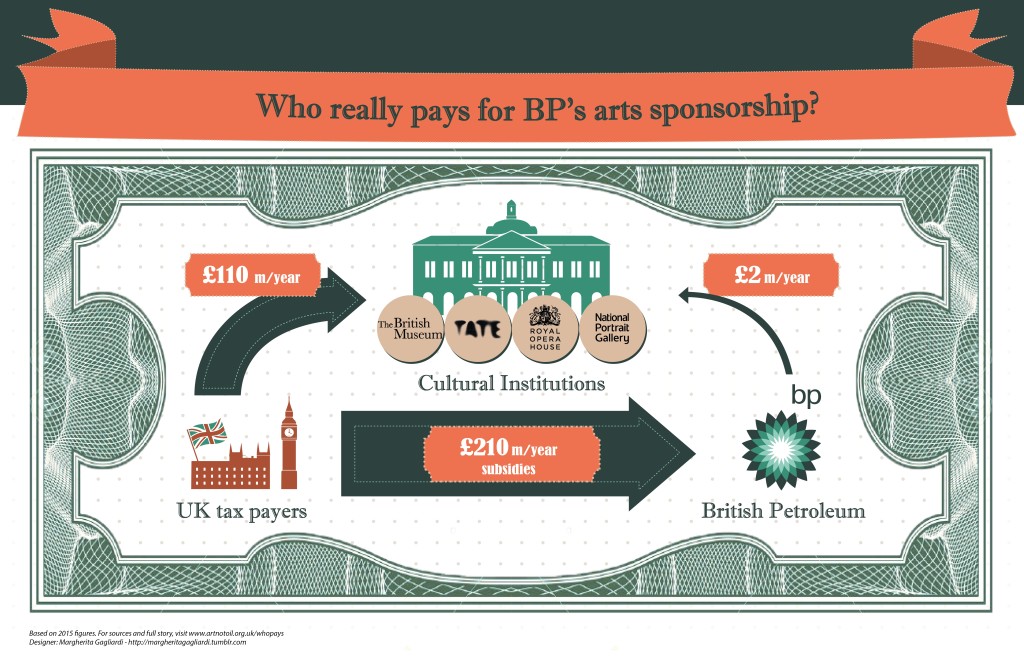
For more than ten years, artists, museum-goers, and campaigners have called for the stain of oil to be wiped from Britain’s most treasured cultural institutions. No more should the British Museum or the National Portrait Gallery serve as advertising billboards to be covered with BP logos.
Today, we released a new infographic revealing who really funds BP’s arts sponsorship: taxpayers. Each year, the UK government hands over £200 million of public money to BP in the form of tax breaks and subsidies. In turn, BP pockets 99%, and uses the remaining £2 million in a not-so-subtle attempt to buy social license.
Social license is a hot commodity for the fossil fuel industry these days. With science clearly proving that there is little room left for expanding the production of oil, coal, and gas, companies like BP are desperate to keep growing and profiting, even if it means climate catastrophe.
Sponsorships provide companies with some of the cheapest advertising available. In BP’s case, all this scheme requires is skimming off a tiny portion of the subsidies it receives from British taxpayers. In turn, the company uses its purportedly generous gesture to position itself as a good corporate citizen – and a key part of Britain’s future – in spite of its central role in worsening climate change. Furthermore, BP often gets to intervene in curatorial decisions; as one British Museum staff member commented, “They are extremely demanding of the Museum – bullying, I would say.”
It also means that BP gets access to prestigious venues on the cheap, which it uses for deal-making and staff functions. For example, BP funded a festival of Mexican culture at the British Museum in 2015 and used it to gain access to the country’s ambassador, just months before Mexico awarded its first offshore oil development contracts, including some awarded to BP. Indeed, the head of BP UK has admitted, “naturally we are going to try to match a particular exhibition with somewhere we have an interest.”
These sponsorship deals aren’t good for the institutions, whose have seen their reputations soiled and their independence compromised. So why do they do it? They are quick to point to diminishing funding:
“Our funding has been cut,” says Richard Lambert, chairman of the British Museum. “And it is very costly to put on a blockbuster show. We need to raise the money from somewhere.”
Nicholas Cullinan, director of the National Portrait Gallery, makes the same argument: “At a time when funding for public institutions is increasingly stretched, the support of the arts that BP provides is vital.”
But a closer looks shows that this claim is misplaced. While it is true that the government has cut arts funding, at the same time it has given ever-larger amounts to the oil and gas industry. Considerably more public funding could be provided for culture by cutting out the middleman and ending perverse subsidies for oil. Art Not Oil and Oil Change International commissioned designer Margherita Gagliardi to paint a picture of this perverse flow of public funds in a new infographic. We focus on 2015, the most recent year for which data are available.
Over the 2015/16 tax year, the British Museum, National Portrait Gallery, Royal Opera House, and Tate Britain collectively received £110 million in funding from central government [1], more than 50 times as much as they got from BP. 2015 was the fourth year of a joint five-year sponsorship deal, in which BP provided £10 million to the four institutions, an average of just £2 million a year.
But here is the most shocking figure: The British government gave a net £200 million to BP in 2015. In other words, subsidies from the government exceeded the total taxes paid by the company by a staggering £200 million. Whereas North Sea oil used to be a source of revenue for the Treasury, today subsidies have become so extreme that the government actually pays BP to extract oil.
So far, the world has warmed by about 1°C since pre-industrial times. In the 2015 Paris Agreement, governments agreed to aim to limit warming to 1.5°C, and to keep it “well below” the danger level of 2°C. Yet as a transition to clean energy becomes ever more urgent, these perverse subsidies to oil and gas serve to press on the warming accelerator.
Meanwhile, BP’s use of a small piece of its government handout to sponsor high-profile culture helps it position itself as an apparently worthy recipient of more funds. Like the Dirty Energy Money Cycle in United States politics, BP spends a comparatively small amount of money to gain enormous political and economic benefits.
Oil subsidies are increasing massively. Former Chancellor George Osborne’s last two Budgets in 2015 and 2016 transferred billions of government funds to the industry. Not only did his successor Philip Hammond decline to reverse the handouts, he has started a review of whether they should go further. With BP a major recipient of limited government funds, perhaps we should look not at how much BP gives in arts sponsorship, but how much it takes away.
One bright spot is that protest is proving increasingly effective. Last year, the Tate ended a 25-year relationship with BP following years of consistent protests by artists and art-lovers, and was followed soon after by the Edinburgh Festival. While funding was renewed for the British Museum, National Portrait Gallery, Royal Opera House, and Royal Shakespeare Company (now reduced to £1.5m per year), continued protests are helping make the sponsorship a reputational liability rather than asset for BP.
Notes:
[1] Here’s much the “Big Four” BP-sponsored institutions got from the Department for Culture, Media and Sport and/or Arts Council England in 2015-16:
- British Museum: £39.2m revenue and £2.6m capital grant-in-aid [https://www.britishmuseum.org/pdf/BM-report-and-accounts-2015-2016.pdf]
- National Portrait Gallery: £6.6m grant-in-aid [https://www.gov.uk/government/uploads/system/uploads/attachment_data/file/541073/56073_HC_453_PRINT.pdf]
- Royal Opera House: ACE-NPO & Bridge £25.8m and ACE – capital grant £2.7m (2015) [https://s3-eu-west-1.amazonaws.com/static.roh.org.uk/about/annual-review/pdfs/annual_review_1415.pdf]
- Tate: £32.7m grant-in-aid [http://www.tate.org.uk/download/file/fid/103595]
Total for the Big Four: £109.6 million
